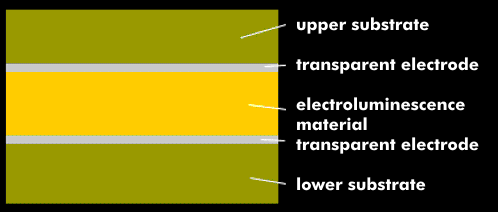electro luminescence display (ELD)
Like plasma displays and cathode ray tubes, Electro Luminescence Displays( ELD) are self-emitting displays. Such an EL display consists of two substrate plates with vapor-deposited transparent electrodes. Between these plates is an electroluminescent layer of zinc sulfide( ZnS).
The ZnS layer of an EL display is extremely thin and transparent. The electroluminescent material is excited by high-energy charge carriers and emits light. The excitation voltages are around 100 kV/cm and have a direct influence on the emitted luminance.
The electroluminescence process dates back to the 1930s, but could not be produced until the 1980s. The displays at that time were monochrome and were used in watches, wristwatches, cell phones and car dashboards. The attempt to turn monochrome displays into color displays by means of color filters was not crowned with success due to limitations in brightness. It was not until the 1990s that pure EL color displays could be produced.
Currently, color EL displays are used in medical and industrial equipment. The disadvantages are the relatively high power consumption and the limited color representation.

